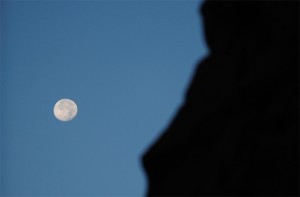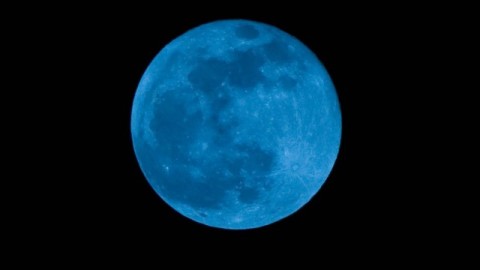World News – For many if they are able to go out tonight and take a look at a clear sky they will see what is referred to as a “blue moon”. This does not happen very often and if you are in an area where you are able to see it then go ahead and take a glance.
 When the moon rises Tuesday night (Aug. 20), it brings us the August full moon and in addition, it will also technically be a “Blue Moon.”
When the moon rises Tuesday night (Aug. 20), it brings us the August full moon and in addition, it will also technically be a “Blue Moon.”
We need gravity: It anchors us. But the gravity we experience on Earth is very different from the gravity on the moon, and both, it turns out, can fluctuate due to a number of things!
“But wait a minute,” you may ask. “Isn’t a Blue Moon defined as the second full moon that occurs during a calendar month? Tuesday’s full moon will be the only full moon of August 2013. So how can we call it a ‘Blue’ moon?”
Yet it still is a Blue Moon, but only if we follow a now somewhat obscure rule of astronomy. In fact, the current “two full moon in one month” rule has superseded the rule that would allow us to call Tuesday’s full moon “blue.”
Confused yet? Well, as the late Paul Harvey used to say, here now, is the rest of the story:
A Blue Moon: The Almanac Moon Rule
Back in the July 1943 issue of “Sky & Telescope magazine, in a question and answer column written by Lawrence J. Lafleur, there was a reference made to the term “Blue Moon.” Lafleur cited the unusual term from a copy of the 1937 edition of the now-defunct Maine Farmers’ Almanac (NOT to be confused with The Farmers’ Almanac which is still published in Lewiston, Maine).
On the Maine Farmers’ almanac page for August 1937, the calendar definition of the Blue Moon explained that occasionally “one of the four seasons would contain four full moons instead of the usual three.”
“There are seven Blue Moons in a Lunar Cycle of nineteen years,” continued the Almanac, ending on the comment: “In olden times the almanac makers had much difficulty calculating the occurrence of the Blue Moon and this uncertainty gave rise to the expression ‘Once in a Blue Moon.'”
Video of Blue Moon
While LaFleur quoted the Almanac’s account, he made one important omission: He never specified any date for the Blue Moon. And as it turned out, in 1937 it occurred on Aug. 21. That was the third full moon in the summer of 1937, a summer season that would see a total of four full moons.
Names were assigned to each moon in a season: For example, the first moon of summer was called the early summer moon, the second was the midsummer moon, and the last was called the late summer moon. But when a particular season has four moons the third was apparently called a Blue Moon so that the fourth and final one can continue to be called the late moon.
So where did we get the “two full moons in a month is a Blue Moon rule” that is so popular today?
Pruett’s Mistake
Once again, we must turn to the pages of Sky & Telescope. This time to page 3 of the March 1946 issue.
In that issue, author James Hugh Pruett wrote the article “Once in a Blue Moon” in which he made a reference to the term “Blue Moon” and referenced LaFleur’s S&T article from July 1943. But because Pruett had no specific dates to fall back on, his interpretation of the ruling given by the Maine Farmers’ Almanac was highly subjective. Pruett ultimately came to this conclusion:
“Seven times in 19 years there were — and still are — 13 full moons in a year. This gives 11 months with one full moon each and one with two. This second in a month, so I interpret it, was called Blue Moon.”
How unfortunate that Pruett did not have a copy of that 1937 almanac at hand, or else he would have almost certainly noticed that his “two full moons in a single month assumption” would have been wrong. For the Blue Moon date of Aug. 21 was most definitely not the second full moon that month!
Blue Moon Goes Viral
Pruett’s 1946 explanation was, of course, the wrong interpretation and it might have been completely forgotten were it not for Deborah Byrd who used it on her popular National Public Radio program, StarDate on Jan. 31, 1980. We could almost say that in the aftermath of her radio show, the incorrect Blue Moon rule “went viral.” Over the next decade, this new Blue Moon definition started appearing in such diverse places such as the Kids edition of the World Almanac, and the board game Trivial Pursuit.
I must confess that even I was involved in helping to perpetuate the new Blue Moon phenomenon. More than 30 years ago, in the Dec. 1, 1982 edition of The New York Times, I made reference to it in the “New York Day by Day” column.
And by 1988 the new definition started receiving international press coverage.
Today, Pruett’s misinterpreted “two full moons in a month rule” is recognized worldwide. Indeed, Sky & Telescope turned a literary lemon into lemonade, proclaiming later that — however unintentional — it changed pop culture and the English language in unexpected ways.
Meanwhile, the original Maine Farmers’ Almanac rule had been all but forgotten.
Playing by the (Old) Rules
Now, let’s come back to this August’s full moon. Under the “old” Almanac rule, Tuesday’s lunar event will be a “Blue Moon.”
In northern summer of 2013, there are four full moons: They occur on June 23, July 22, Aug. 20 and Sept. 19.
This means that under the original Maine Almanac rule — the one promoted by Lafleur and later misinterpreted by Pruett — the third full moon of the 2013 summer season on Aug. 20 would be a Blue Moon.
Final Full Moon Thoughts
So what blue moon definition tickles your fancy? Is it the second full moon in a calendar month, or (as is the case on Tuesday) the third full moon in a season with four? Maybe it’s both. The final decision is solely up to you.
Tuesday’s full moon will look no different than any other full moon. But the moon can change color in certain conditions. After forest fires or volcanic eruptions, the moon can appear to take on a bluish or even lavender hue.
Soot and ash particles, deposited high in the Earth’s atmosphere, can sometimes make the moon appear bluish. In the aftermath of the massive eruption of Mount Pinatubo in the Philippines in June 1991 there were reports of blue moons (and even blue suns) worldwide.
And in case you’re wondering when the next time we’ll have two full moons in a calendar month — call it “Pruett’s Blue Moon Rule” — that will happen in July 2015. The second full moon in that month, the Blue Moon, will come on July 31 of that year.
BY JOE RAO, SPACE.COM SKYWATCHING COLUMNIST

